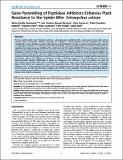Por favor, use este identificador para citar o enlazar a este item:
http://hdl.handle.net/10261/96099COMPARTIR / EXPORTAR:
 SHARE SHARE
 CORE
BASE CORE
BASE
|
|
| Visualizar otros formatos: MARC | Dublin Core | RDF | ORE | MODS | METS | DIDL | DATACITE | |

| Título: | Gene pyramiding of peptidase inhibitors enhances plant resistance to the spider mite tetranychus urticae |
Autor: | Santamaría, María Estrella; Cambra, Inés; Martínez, Manuel; Pozancos, Clara; González-Melendi, Pablo; Grbić, Vojislava CSIC ORCID; Castañera, Pedro CSIC; Ortego, Félix CSIC ORCID ; Díaz, Isabel | Palabras clave: | Genetically modified plants Winter cereals Barley Pest control Red spider mite |
Fecha de publicación: | 10-ago-2012 | Editor: | Public Library of Science | Citación: | PLoS ONE 7(8): e43011 | Resumen: | The two-spotted spider mite Tetranychus urticae is a damaging pest worldwide with a wide range of host plants and an extreme record of pesticide resistance. Recently, the complete T. urticae genome has been published and showed a proliferation of gene families associated with digestion and detoxification of plant secondary compounds which supports its polyphagous behaviour. To overcome spider mite adaptability a gene pyramiding approach has been developed by coexpressing two barley proteases inhibitors, the cystatin Icy6 and the trypsin inhibitor Itr1 genes in Arabidopsis plants by Agrobacterium-mediated transformation. The presence and expression of both transgenes was studied by conventional and quantitative real time RT-PCR assays and by indirect ELISA assays. The inhibitory activity of cystatin and trypsin inhibitor was in vitro analysed using specific substrates. Single and double transformants were used to assess the effects of spider mite infestation. Double transformed lines showed the lowest damaged leaf area in comparison to single transformants and nontransformed controls and different accumulation of H2O2 as defence response in the leaf feeding site, detected by diaminobenzidine staining. Additionally, an impact on endogenous mite cathepsin B- and L-like activities was observed after feeding on Arabidopsis lines, which correlates with a significant increase in the mortality of mites fed on transformed plants. These effects were analysed in view of the expression levels of the target mite protease genes, C1A cysteine peptidase and S1 serine peptidase, identified in the four developmental mite stages (embryo, larvae, nymphs and adults) performed using the RNA-seq information available at the BOGAS T. urticae database. The potential of pyramiding different classes of plant protease inhibitors to prevent plant damage caused by mites as a new tool to prevent pest resistance and to improve pest control is discussed | Versión del editor: | http://dx.doi.org/10.1371/journal.pone.0043011 | URI: | http://hdl.handle.net/10261/96099 | DOI: | 10.1371/journal.pone.0043011 | ISSN: | 1932-6203 |
| Aparece en las colecciones: | (CIB) Artículos |
Ficheros en este ítem:
| Fichero | Descripción | Tamaño | Formato | |
|---|---|---|---|---|
| PLOS_ONE Pedro Castañera pone.0043011.pdf | 466,53 kB | Adobe PDF |  Visualizar/Abrir |
CORE Recommender
PubMed Central
Citations
38
checked on 31-mar-2024
SCOPUSTM
Citations
67
checked on 09-abr-2024
WEB OF SCIENCETM
Citations
61
checked on 23-feb-2024
Page view(s)
411
checked on 16-abr-2024
Download(s)
247
checked on 16-abr-2024
Google ScholarTM
Check
Altmetric
Altmetric
Artículos relacionados:
NOTA: Los ítems de Digital.CSIC están protegidos por copyright, con todos los derechos reservados, a menos que se indique lo contrario.
